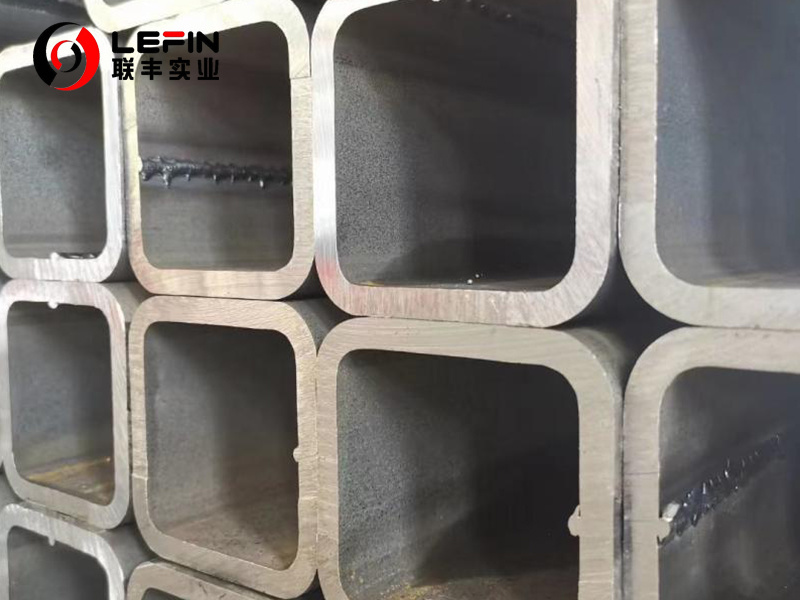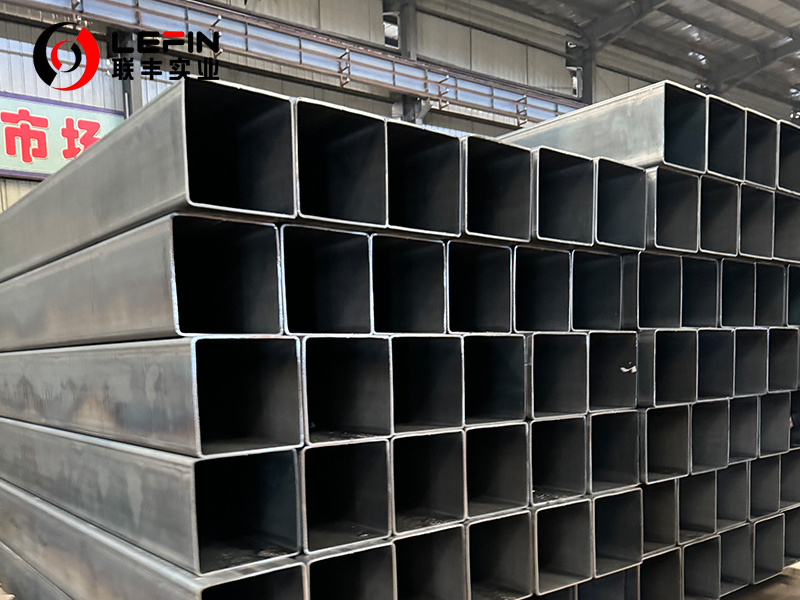


- Details
-
ASTM A500 is a widely used standard for cold-formed welded and seamless carbon structural steel pipes, especially suitable for structural fields such as construction and Bridges. The following is a detailed explanation from aspects such as advantages, technical requirements, steel grade classification, application scenarios, selection methods, and differences from ASTM A501:
I. Advantages of ASTM A500
High structural strengthThe cold forming process is adopted to enhance the yield strength and tensile strength of the material, making it suitable for load-bearing structures.
High dimensional accuracyThe tolerance of outer diameter and wall thickness is strictly controlled (such as the deviation of outer diameter ≤0.5% to 0.75%) to ensure installation compatibility.
Diversified specificationsIt covers circular, square, rectangular and irregular cross-sections, with the maximum external dimension reaching 1,626mm, and is suitable for complex designs.
Good economyCompared with Tube products (such as ASTM A450), Pipe has higher production efficiency and lower cost.
II. Core Requirements of the Standard
Manufacturing processOptional welding (resistance welding) or seamless process is available. For welded pipes, the strength of the weld seam must be guaranteed.
Chemical compositionSeparate furnace analysis and product analysis are carried out, with strict control over elements such as carbon (C≤0.26%), manganese (Mn≤1.35%), phosphorus (P≤0.035%), and sulfur (S≤0.035%).
Mechanical performanceTensile strength and yield strength are classified by steel grade (see the table below);
The elongation is required to be calculated based on the wall thickness (for example, when the wall thickness is ≤3.05mm, the elongation =56t+17.5).
Test requirementsFlattening test: To detect the ductility of the weld seam and the integrity of the pipe body;
Dimensional tolerance: The outer diameter, wall thickness, straightness, etc. must comply with strict standards (for example, the Angle tolerance between adjacent surfaces of a rectangular tube should be ≤2°).

Comparison of mechanical properties of ASTM A500 steel grade:
Steel Grade Minimum yield strength (MPa) Minimum tensile strength (MPa) Typical application scenarios Grade A 228 310 lightweight structure, support Grade B 290 400 building frame, conveying system Class C 317 427 high-load structures and mechanical components Class D 250 400 Scenarios requiring low-temperature toughness III. Common Application Fields
Building structure: stair railings, roof trusses, columnsBridge engineering: Auxiliary support structure
Mechanical manufacturing: Conveyor system supports, equipment frames
Traffic facilities: Street lamp poles, traffic sign poles.
IV. Guide to steel grade selection
Grade A/B: Conventional building structures (such as shopping mall brackets, warehouse frames), with high cost performance;Class C: Heavy machinery or high-stress components (such as crane booms);
Grade D: In low-temperature environments (such as Bridges in cold regions) or dynamic load scenarios, it is necessary to ensure impact resistance.

V. Differences from ASTM A501
ASTM A501 is a thermoformed structural tube. The main differences from A500 are as follows:
Comparison of core differences between ASTM A500 and A501
Characteristics ASTM A500 ASTM A501 Forming process Cold forming hot forming (hot rolling or hot expanding) Strength characteristics higher yield strength (cold work hardening) lower yield strength, and better ductility Applicable standard building main structure, secondary structure or non-critical support Lower cost (high production efficiency) Higher energy consumption and process complexity Application priority Mainstream choice It was gradually replaced by the A500
Note: A501 is currently used less frequently, while A500 has become mainstream due to its advantages in cost performance and strength.
Summary
ASTM A500 has become the preferred pipe material in the fields of construction and machinery due to its high precision, strong structural strength and economy.The selection of steel grades should take into account the load, environment (such as low temperature) and cost. Grade B or C should be given priority.
Compared with A501, A500 has more advantages in terms of strength, cost and application breadth, especially being irreplaceable in the main load-bearing structure.
It is recommended to give priority to referring to the ASTM A500 standard during the design, and strictly verify the weld quality and low-temperature toughness (if grade D is selected).
ASTM A500 PIPE
Subcategory
Keyword
- Details
-
ASTM A500 is a widely used standard for cold-formed welded and seamless carbon structural steel pipes, especially suitable for structural fields such as construction and Bridges. The following is a detailed explanation from aspects such as advantages, technical requirements, steel grade classification, application scenarios, selection methods, and differences from ASTM A501:
I. Advantages of ASTM A500
High structural strengthThe cold forming process is adopted to enhance the yield strength and tensile strength of the material, making it suitable for load-bearing structures.
High dimensional accuracyThe tolerance of outer diameter and wall thickness is strictly controlled (such as the deviation of outer diameter ≤0.5% to 0.75%) to ensure installation compatibility.
Diversified specificationsIt covers circular, square, rectangular and irregular cross-sections, with the maximum external dimension reaching 1,626mm, and is suitable for complex designs.
Good economyCompared with Tube products (such as ASTM A450), Pipe has higher production efficiency and lower cost.
II. Core Requirements of the Standard
Manufacturing processOptional welding (resistance welding) or seamless process is available. For welded pipes, the strength of the weld seam must be guaranteed.
Chemical compositionSeparate furnace analysis and product analysis are carried out, with strict control over elements such as carbon (C≤0.26%), manganese (Mn≤1.35%), phosphorus (P≤0.035%), and sulfur (S≤0.035%).
Mechanical performanceTensile strength and yield strength are classified by steel grade (see the table below);
The elongation is required to be calculated based on the wall thickness (for example, when the wall thickness is ≤3.05mm, the elongation =56t+17.5).
Test requirementsFlattening test: To detect the ductility of the weld seam and the integrity of the pipe body;
Dimensional tolerance: The outer diameter, wall thickness, straightness, etc. must comply with strict standards (for example, the Angle tolerance between adjacent surfaces of a rectangular tube should be ≤2°).

Comparison of mechanical properties of ASTM A500 steel grade:
Steel Grade Minimum yield strength (MPa) Minimum tensile strength (MPa) Typical application scenarios Grade A 228 310 lightweight structure, support Grade B 290 400 building frame, conveying system Class C 317 427 high-load structures and mechanical components Class D 250 400 Scenarios requiring low-temperature toughness III. Common Application Fields
Building structure: stair railings, roof trusses, columnsBridge engineering: Auxiliary support structure
Mechanical manufacturing: Conveyor system supports, equipment frames
Traffic facilities: Street lamp poles, traffic sign poles.
IV. Guide to steel grade selection
Grade A/B: Conventional building structures (such as shopping mall brackets, warehouse frames), with high cost performance;Class C: Heavy machinery or high-stress components (such as crane booms);
Grade D: In low-temperature environments (such as Bridges in cold regions) or dynamic load scenarios, it is necessary to ensure impact resistance.

V. Differences from ASTM A501
ASTM A501 is a thermoformed structural tube. The main differences from A500 are as follows:
Comparison of core differences between ASTM A500 and A501
Characteristics ASTM A500 ASTM A501 Forming process Cold forming hot forming (hot rolling or hot expanding) Strength characteristics higher yield strength (cold work hardening) lower yield strength, and better ductility Applicable standard building main structure, secondary structure or non-critical support Lower cost (high production efficiency) Higher energy consumption and process complexity Application priority Mainstream choice It was gradually replaced by the A500
Note: A501 is currently used less frequently, while A500 has become mainstream due to its advantages in cost performance and strength.
Summary
ASTM A500 has become the preferred pipe material in the fields of construction and machinery due to its high precision, strong structural strength and economy.The selection of steel grades should take into account the load, environment (such as low temperature) and cost. Grade B or C should be given priority.
Compared with A501, A500 has more advantages in terms of strength, cost and application breadth, especially being irreplaceable in the main load-bearing structure.
It is recommended to give priority to referring to the ASTM A500 standard during the design, and strictly verify the weld quality and low-temperature toughness (if grade D is selected).
Related products
Product Consulting

Address: Hengtai Road,Daqiuzhuang Town,Jinghai County,Tianjin,China
Mob: +8615122229899(whatspp)
Phone: +86 22 58171905
Fax: +86 22 58171902
E-mail:info@lefinsteel.com
Get company updates

Tianjin Lefin Industrial Co.,Ltd. All rights reserved City sub-station SEO www.300.cn

